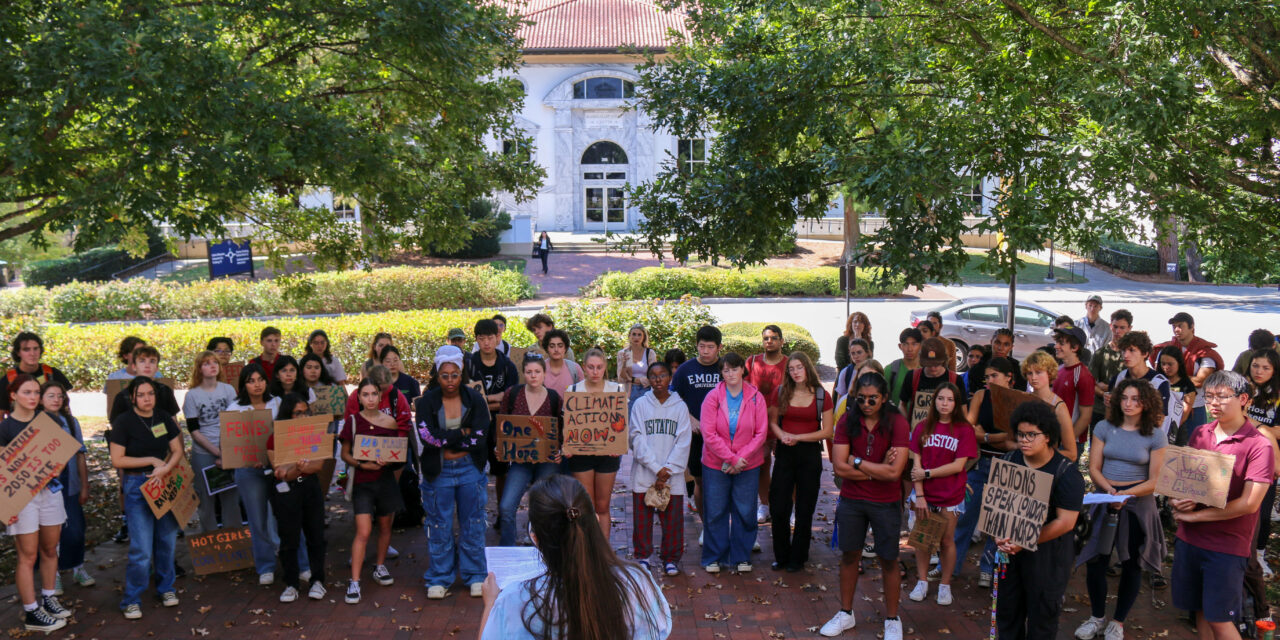Approximately 60 students gathered at the edge of Asbury Circle with cardboard signs for Emory University’s fifth annual Climate Strike on Sept. 29. The students ended their march at the Administration Building, demanding for University administration to review and approve Emory’s Climate Action Plan.
A group of students, faculty, administrators and community professionals called the Climate Action Task Force have spent about a year drafting this plan, which closed for public comment on Sept. 13. The next draft is expected to be published on Oct. 13, 2023.
Emory Climate Reality Project President Emery Hill (25C), who was part of the Climate Action Task Force, said that Emory’s new plan is “comprehensive.” She said the plan addresses nine sections such as emissions reductions and carbon management, equity and justice and food, waste and procurement.
However, student climate activists are concerned that the plan does not include provisions for implementing the changes it describes. Emory Climate Reality Project co-Vice President and participant in the strike Matthew Veerasammy (26C) said students want to ensure there are no loopholes in the plan.
“We want to make sure we strengthen the plan to ensure that not only the students are accommodated, but also to ensure that everything that we want to pursue for the environment is actually happening on campus,” Veerasammy said.
Students are also calling for the plan to include a timeline for completing each initiative, as well as require administration to delegate parts of the plan to different offices and set aside monetary resources for new climate-friendly infrastructure. Enhancing these sustainability initiatives, including the University becoming net-zero by 2025, will reflect the “imminent danger” of the climate emergency, the Emory Climate Coalition wrote in a public statement regarding the strike.

Students hold signs as they listen to a speech in front of the Administration Building during the fifth annual Climate Strike. (Jack Rutherford/Staff Photographer)
Protestors discussed these concerns during the Climate Strike, which is a collaboration between the Emory Climate Coalition and the Emory Climate Reality Project. Hill said the coalition is composed of the “most involved climate leaders on campus,” including the Climate Reality Project, Emory Climate Analysis Team and the Emory Climate Organization, and its members work directly with administration and faculty to represent the student groups’ sustainability demands.
The strike began with speeches before students began their march to the Administration Building, chanting slogans such as, “Whose streets? Our streets! Whose school? Our school! Whose future? Our future!”
Hill said that the Emory Climate Action Task Force would rather have “hard tangible change” and implementable initiatives rather than “lofty goals” that will they are unsure Emory could meet.
Some of the speakers included Hill, Climate Research Initiative Project Assistant Bryn Davis and Jaanaki Radhakrishnan (26C), who is an organizer involved with the “Stop Cop City” movement. The movement seeks to stop the construction of the Atlanta Public Safety Training Center, citing environmental, civil rights and other concerns. Emory students involved in this movement have called on University President Gregory Fenves to condemn the project and step down from his seat on the Atlanta Committee for Progress, which gave initial approval for the training center’s construction in 2021.
Last year, students leading the strike on Sept. 23 called for transparency from the Emory Administration and hoped that their frustrations would be taken seriously. Student climate activists said that they are still open to working with the administration. The students have three specific demands they want to add to the plan: accountability, urgency and funding.
The strike was made possible by student involvement, Emory Climate Reality Project Treasurer Alekhya Pidugu (24C) said. She explained that the Emory Climate Coalition has grown during her four years at Emory.
“I’m really honored and privileged to be a part of a group that has so much passion for the climate, number one, and also willing to speak up with their voices and see actual change happen and not be afraid to put themselves out there amongst an administration, which is quite scary, to actually fight for what they believe in and to hold the school accountable for being climate forward or wanting climate policies to be changed,” Pidugu said.
Pidugu added that she was excited to see new faces, such as Viola Holmes (27C), at the protest. Holmes decided to attend after reading about the Climate Strike on the signs outside her dorm and believed the event was “pretty cool.”
Additionally, Pidugu said the strike helps students voice their opinions and hold the University accountable.
“If we become complacent, we’re never going to change and you need critical stances such as strikes and demonstrations like these to hold people accountable,” Pidugu said.
Ela Mody (she/her, 27C) is from Cleveland, Ohio, and is a part of the Emory College of Arts and Sciences. She is planning on majoring in Human Health and Psychology. She is on the Events Committee of APIDAA and a member of club field hockey. In her free time, she likes reading poetry and listening to R&B.







